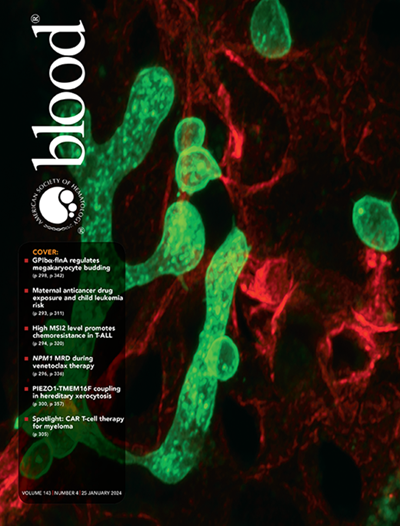Circulating tumor cells predict myeloma outcomes in patients treated with daratumumab, bortezomib, lenalidomide, and dexamethasone.
IF 23.1
1区 医学
Q1 HEMATOLOGY
引用次数: 0
Abstract
Circulating tumor cells (CTC) represent a high-risk biomarker in newly diagnosed multiple myeloma (NDMM); however, their prognostic value among transplant-eligible (TE) patients receiving daratumumab with bortezomib/lenalidomide/dexamethasone (D-VRd) remains unknown. Here, we analyzed CTC in the phase 3 PERSEUS trial (EMN017/NCT03710603). TE patients with NDMM were randomized (1:1) to D-VRd with daratumumab/lenalidomide maintenance (D-VRd group) or VRd with lenalidomide maintenance (VRd group), both with transplant. A subset of 451/709 patients from PERSEUS (D-VRd, 231/355; VRd, 220/354) had screening blood samples collected for CTC analysis by flow cytometry (median follow-up, 47.6 months). CTC were detected in 370/451 (82%) patients (median limit of detection, 0.0004%). CTC were prognostic of progression-free survival (PFS), independently of other factors, as a continuous (HR, 1.36 [95% CI, 1.15-1.60]; P<0.001) and categorical variable (≥0.175% CTC-high, optimal threshold). D-VRd improved PFS versus VRd in CTC-low patients (4-year rates: 88% vs 74%; HR, 0.42 [95% CI, 0.25-0.70]; P=0.0013). Regardless of study treatment, minimal residual disease (MRD)-negativity rates were lower in CTC-high versus CTC-low patients (10-5: 52.2% vs 66.2%; 10-6: 34.8% vs 52.4%). D-VRd significantly increased MRD-negativity rates versus VRd among CTC-high (10-5: 69.4% vs 33.3%; 10-6: 47.2% vs 21.2%; both P<0.05) and CTC-low patients (10-5: 74.4% vs 57.8%; 10-6: 65.6% vs 38.5%; both P<0.001), with similar observations for sustained MRD negativity. CTC levels are an independent prognostic factor in TE-NDMM patients treated with standard-of-care frontline quadruplet. D-VRd improved overall and sustained MRD-negativity rates in CTC-high and CTC-low patients, and improved PFS for CTC-low with a positive trend in CTC-high patients. NCT03710603.循环肿瘤细胞(CTC)是新诊断多发性骨髓瘤(NDMM)的高风险生物标志物;然而,它们在接受达拉单抗联合硼替佐米/来那度胺/地塞米松(D-VRd)治疗的符合移植条件(TE)患者中的预后价值尚不清楚。在这里,我们分析了3期PERSEUS试验(EMN017/NCT03710603)中的CTC。TE NDMM患者被随机(1:1)分为达拉单抗/来那度胺维持的D-VRd组(D-VRd组)或来那度胺维持的VRd组(VRd组),两者均接受移植。来自PERSEUS的451/709例患者(D-VRd, 231/355; VRd, 220/354)通过流式细胞术筛选采集的血液样本进行CTC分析(中位随访时间为47.6个月)。451例患者中有370例(82%)检出CTC(中位检出限为0.0004%)。CTC是独立于其他因素的无进展生存期(PFS)的预后,作为一个连续(HR, 1.36 [95% CI, 1.15-1.60]; P<0.001)和分类变量(≥0.175% CTC-高,最佳阈值)。D-VRd改善了低ctc患者的PFS,而VRd改善了低ctc患者的PFS(4年率:88% vs 74%; HR, 0.42 [95% CI, 0.25-0.70]; P=0.0013)。无论采用何种治疗方法,ctc -高患者的最小残留病(MRD)阴性率低于ctc -低患者(10-5:52.2% vs 66.2%; 10-6: 34.8% vs 52.4%)。与VRd相比,D-VRd显著增加了ctc高患者(10-5:69.4% vs 33.3%; 10-6: 47.2% vs 21.2%, P<0.05)和ctc低患者(10-5:74.4% vs 57.8%; 10-6: 65.6% vs 38.5%, P<0.001)的MRD阴性率,对持续MRD阴性的观察结果相似。CTC水平是采用标准护理一线四联体治疗的TE-NDMM患者的独立预后因素。D-VRd改善了ctc -高和ctc -低患者的总体和持续mrd阴性率,改善了ctc -低患者的PFS, ctc -高患者的PFS呈阳性趋势。NCT03710603。
本文章由计算机程序翻译,如有差异,请以英文原文为准。
求助全文
约1分钟内获得全文
求助全文
来源期刊

Blood
医学-血液学
CiteScore
23.60
自引率
3.90%
发文量
955
审稿时长
1 months
期刊介绍:
Blood, the official journal of the American Society of Hematology, published online and in print, provides an international forum for the publication of original articles describing basic laboratory, translational, and clinical investigations in hematology. Primary research articles will be published under the following scientific categories: Clinical Trials and Observations; Gene Therapy; Hematopoiesis and Stem Cells; Immunobiology and Immunotherapy scope; Myeloid Neoplasia; Lymphoid Neoplasia; Phagocytes, Granulocytes and Myelopoiesis; Platelets and Thrombopoiesis; Red Cells, Iron and Erythropoiesis; Thrombosis and Hemostasis; Transfusion Medicine; Transplantation; and Vascular Biology. Papers can be listed under more than one category as appropriate.
 求助内容:
求助内容: 应助结果提醒方式:
应助结果提醒方式:


